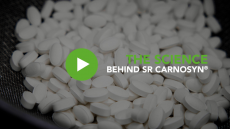Review: Mechanisms of action behind nutritional sarcopenia prevention

Sarcopenia is characterised by an age-related loss of skeletal muscle mass and function and has been recognised as a clinical disease by the World Health Organization since 2016.
Substantial evidence has suggested that dietary modification can be a feasible tool to combat the issue.
This review provides the current knowledge on dietary components with the potential to assist sarcopenia prevention and/or treatment. Among various natural dietary ingredients, the present study focused on botanical and marine extracts, phytochemicals, and probiotics.
The paper describes the ways nutrition can prevent the onset of sarcopenia via maintenance of protein homeostasis, protect against inflammation, enhanced mitochondrial function, and reversal of satellite cell dysfunction.
The authors conclude that further in-depth studies are required to elucidate the role of, and develop various, dietary materials for healthier aging, particularly concerning muscle health.
Protein synthesis
Ageing induces a negative balance between protein synthesis and degradation, the report notes. Specifically, the rate of synthesis of mixed muscle proteins including myofibrillar, mitochondrial, and sarcoplasmic proteins reduces by 30% with advancing age.
Additionally, the synthesis rate of myosin heavy chain (MHC), the contractile protein, is reduced in older people (~77 years of age).
Moreover, mitochondrial protein synthesis decreases with age. In a post-absorptive human study, older men (75 years of age) showed lower postprandial muscle protein synthesis rates than young men (22 years of age) by 16%.
Besides changes in muscle protein synthesis, age-related alteration in protein degradation have also been reported.
Protein synthesis and protein degradation are regulated by different pathways. A major regulatory signaling pathway for protein synthesis involves insulin-like growth factor-1 (IGF-1)—phosphatidylinositol-3-kinase/protein kinase B (PI3K/Akt).
IGF-1 stimulates muscle cells to activate downstream targets, which are required for protein synthesis. This hormone interacts with its tyrosine kinase receptor to phosphorylate insulin receptor substrate (IRS)-1 and activates PI3K/Akt signaling.
Thereafter, phosphorylated Akt activates mTOR, resulting in phosphorylation of ribosomal protein S6 kinase (p70S6K) and the 4Ebinding protein 1 (4E-BP1), which promotes protein synthesis by activating ribosomal protein S6 and releasing eukaryotic translation initiation factor eIF-4E, respectively.
The level of IGF-1, the main anabolic signal in skeletal muscle, decreases with age. Therefore, muscle protein synthesis declines with age.
Discussing potential nutritional interventions that could impact sarcopenia via this pathway, the report states: "Promoting protein synthesis via activation of the PI3K/Akt pathway was reported in three plant-derived extracts from Leonurus japonicus, Chrysanthemum morifolium Ramat, and oligonol and four phytochemicals including leonurine, isochlrogenic acid A, corylifol A, and 5,7-dimethoxyflavone (DMF)."
Mitochondrial dysfunction and biogenesis
Mitochondrial biogenesis is a process that generates new mitochondria, with an increase in the number and density of mitochondria. In the muscle, which has a high metabolic rate, mitochondrial biogenesis is particularly important for producing ATP, which can facilitate muscle contraction and impact physical performance.
Mitochondrial dysfunction is suggested as a pathophysiology of sarcopenia as impaired mitochondrial biogenesis and mitochondrial dynamics have been proposed to cause mitochondrial dysfunction in sarcopenic muscles.
Compared to those in young participants (22–24 years old), 50% of expression levels of key metabolic regulators of mitochondrial biogenesis, including sirtuin 3 (Sirt3) and Pgc-1α in the skeletal muscle of aged subjects (75–81 years old) was observed.
Moreover, individuals with sarcopenia exhibited reduced expression levels of Pgc-1α, ERRα, and other coactivators, such as Nrf-1 and Nrf2, compared with those in individuals without sarcopenia.
Discussing the issues of 'satellite cell dysfunction' as another mechanism behind sarcopenia, the report explains: "Skeletal muscle stem cells regenerate repeatedly throughout life and preserves skeletal muscle integrity, contributing to muscle mass and muscle regeneration after injury. Thus, SC dysfunction has been suggested to be closely related to the onset and progression of sarcopenia."
Inflammation
Age-Related Chronic Low-Grade Inflammation The increase in inflammation during the aging process, also known as inflammaging, has been suggested as one of the significant contributors to sarcopenia.
The authors note a number of ingredients scientifically shown to reduce inflammation, including: Korean red ginseng, olive leaf, leonurine, quercetin, Diphlorethohydroxycarmalol (DPHC), and Lactobacillus paracasei PS23.
A reduction of pro-inflammatory cytokine levels was reported in two plant-derived extracts from ginseng and olive leaf and a phytochemical curcumin using in vitro or in vivo sarcopenic models. Oh et al. reported that the non-saponin fraction (NSF) of Korean red ginseng decreased the release of pro-inflammatory cytokines including IL-1, IL-6, TNF-α, and CRP in the serum of aged C57BL/6 mice compared with that in non-treated aged mice.
Want to learn more about sarcopenia and supporting ageing consumers to remain fit and strong? NutraIngredients Europe's newly branded Active Nutrition Summit in Amsterdam, 0ct 9-11, will delve into this topic further.
An evolution of the brand's prominent annual Sports & Active Nutrition Summit, this year’s event will provide delegates with insights into the increasingly holistic and mass market view of sports nutrition, from some of the leading names in the industry.
Content pillars will cover all the hottest topics in the industry today including cognitive health, women’s health, life-stages nutrition, and personalisation.
Source: Nutrients
https://doi.org/10.3390/nu15112625
"A Comprehensive Review of Pathological Mechanisms and Natural Dietary Ingredients for the Management and Prevention of Sarcopenia"
kim. J., et al













